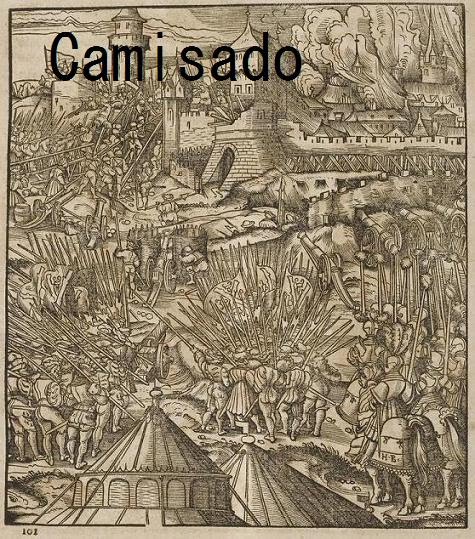Today's post shows a couple of bases newly completed to compliment the units of peasants I have recently painted. Whilst I've tried to make the bulk of the peasants as generic as possible, so they can be used in Tudor and German Peasants' Wars games with some of them also being useful for various town militias, these two bases are very much particular to the German Peasants War of 1524-1526.
The first base shows a radical preacher, a peasant captain and a landsknecht with a couple of standards behind them. One of the "standards" is simply a peasant boot atop a pole with the lace hanging down. This represents the "Bundschuh" or band shoe, as the peasants organised themselves into relatively well organised bands during their uprisings and this was sometimes used as their emblem, as an actual boot or on a banner. Douglas Miller's excellent book "The German Peasant's War 1524-1526" seems to indicate that the "Bundschuh" flag was perhaps not really that common in the wars. The "Bundschuh" movement was earlier, referring to a series of uprisings in Germany that took place between 1493 and 1517. Miller states "In the summer of 1524, the first uprisings of the Peasants' War took place in an area of the earlier Bundschuh conspiracies in southwestern Germany, but this emblem depicting a form of leather shoe held together by straps, seldom appeared during the war". Miller goes on to state two flags bearing the symbol have survived from the period whilst a third is referred to in a Metz Chronicle. The banner does appear in a contemporary stained glassed window and in a later, 1539, woodcut which is shown below.
I think the inclusion of the shoe and the Preacher really help to set this command base firmly in the German Peasants' wars of the 1520s. The landsknecht with the two handed sword and the preacher are Warlord Games figures. The peasant captain and standard bearer holding the pole with the shoe are Steel Fist miniatures and the landsknecht standard bearer is an old Wargames Foundry miniature.
 |
| A view of the command base from behind. This picture gives a clearer view of the "Bundschuh" carried on the end of a pole. |
 |
| 1539 Woodcut showing a "Bundschuh" image on a banner. |
The second base completed for the German Peasants' wars collection shows two mounted scouts. The peasant armies were woefully short of cavalry during their 1520s uprisings, this being one of the main reasons for their brutal defeats. They lacked the suitable horses and did not have the same mounted training at arms that the ruling classes had. One troop of "peasant" horse is recorded in the Mühlhausen band led by Claus Pfannenschmidt but the mounted troops the peasants did have would be used a scouts and messengers, which is what I have chosen to depict here.
The figures are both from the old Front Rank miniature Wars of the Roses range, now sold by Gripping Beast. Although for the Wars of the Roses the sculpts look like they have been based on the below 1517 image from the Triumphal Procession of Emperor Maximilian I (I have seen this image attributed to both Albrecht Altdorfer and Hans Burgkmair so haven't put a name below it). The figures have had the whips they were carrying replaced with lances, in case they encounter any hostile cavalry on their scouting missions. As with the first base they really have the period feel and will add some character to the German Peasants army.
 |
| Two horsemen from Triumphal Procession of Emperor Maximilian I c.1517. |
 |
| Two mounted peasant scouts who have been keeping and eye on the movements of the Swabian League. |





